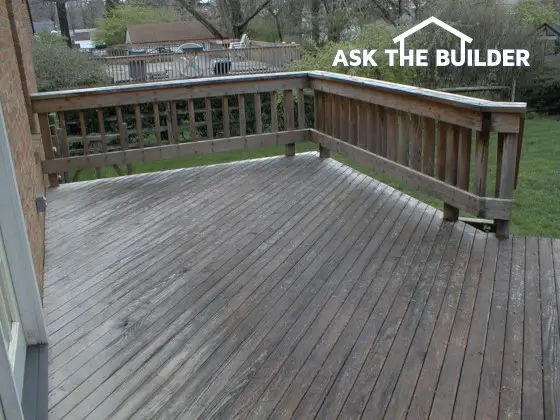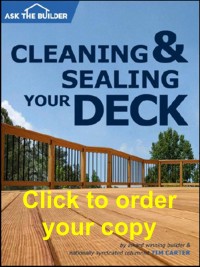Deck Cleaning Dilemma

Deck Cleaning Dilemma
DEAR TIM: My older CCA treated lumber deck has me very concerned. Television reports and print articles have implied that CCA lumber has been banned by the Environmental Protection Agency (EPA). Can I safely clean and seal my existing deck or do I need to replace it with a different wood? What can I do to minimize any hazard that might be present with this chemically treated lumber product? What is the best way to clean and seal my wood deck? Cary G., Norfolk, VA
DEAR CARY: It is my guess that the television and print editors were either tired, over-zealous or asleep at their desks if you are accurately describing what you saw and read. The EPA released a statement on February 12, 2002 that among other things stated, "EPA has not concluded that CCA-treated wood poses unreasonable risks to the public for existing CCA-treated wood being used around or near their homes or from wood that remains available in stores. EPA does not believe there is any reason to remove or replace CCA-treated structures, including decks or playground equipment. EPA is not recommending that existing structures or surrounding soils be removed or replaced." That being said, I feel your existing decking is fine if you treat it with some respect.
The CCA chemical treatment of wood has been used since the 1940's. Copper, chromium, and arsenic are dissolved in water and then injected into the lumber under high pressure. The three chemicals act as a preservative and inhibit attack by insects and wood destroying fungi that typically would cause untreated wood to be destroyed or rot when subject to outdoor elements. During the past few years the general public has formed a perception that unsafe amounts of these chemicals are leaching from the treated wood.
The fact is that chemicals can leach from the wood. Remember, they are water soluble. This means that rain water or snow melt can soak into treated lumber and put the chemicals back into solution. This tainted water can then flow off or under the deck and possibly contaminate you, your children or your surrounding ground. Are there enough chemicals to be concerned about? I imagine it depends upon which study you believe. Currently the EPA feels that the lumber does not pose an "unreasonable" risk.
But stop and think of the dynamics of what is going on. Since we know the chemicals dissolve in water, you can minimize and possibly eliminate any risk if you stop water from entering the wood in the first place. This can be achieved successfully and easily if you treat the deck with a top quality synthetic resin water repellent. These products seem to work better than many popular deck sealants that contain natural oils. What's more, the natural oil products become food for algae and mildew as the mildewcides in the products wear off. In short order, many decks using natural oil sealers tend to turn black and green as the algae and mildew feast on the sealers. The synthetic resin sealers do not support mildew and algae growth.
 Decks need to be very clean before you treat them. The use of pressure washers, in my opinion, has never been a good idea. The pressurized stream of water can erode the soft light colored spring wood that is found between the darker grains of summer wood in each piece of lumber. I am now concerned that pressure washers can inject water deep into the lumber and bring back with it some of the CCA chemicals. It is also my feeling that if you collected the water that is blasted from the deck by the pressure washer you would find it contains millions of tiny wood fibers that contain the CCA chemicals.
Decks need to be very clean before you treat them. The use of pressure washers, in my opinion, has never been a good idea. The pressurized stream of water can erode the soft light colored spring wood that is found between the darker grains of summer wood in each piece of lumber. I am now concerned that pressure washers can inject water deep into the lumber and bring back with it some of the CCA chemicals. It is also my feeling that if you collected the water that is blasted from the deck by the pressure washer you would find it contains millions of tiny wood fibers that contain the CCA chemicals.
Quite possibly a safer way to clean wood decks is the use of oxygen bleach. This product is a non-toxic powder that dissolves in water. It is not harsh as is chlorine bleach. Oxygen bleach does not remove the color from wood. It does not kill surrounding vegetation as does chlorine bleach. Many off the shelf deck cleaning products contain chlorine bleach but they disguise it using the chemical name. Avoid products that contain sodium hypochlorite - the chemical name for chlorine bleach.
Once the oxygen bleach dissolves in water, you simply apply the solution to your deck. Keep the deck wet with the solution and stand back and watch as millions of tiny oxygen bubbles work to clean the wood. After a 10 or 15 minute wait, lightly brush the wood with a broom or scrub brush and then rinse with water using an ordinary low pressure garden hose. The results will be outstanding. You only need to wait several hours to seal the deck if you purchase a water based environmentally friendly synthetic resin deck sealer. Keep the deck sealed every two years and I think you can stop worrying.
| Message from Tim Carter: |
Years ago while researching a column about cleaning decks, I discovered the wonders of Oxygen Bleach. It is perhaps the 'greenest' cleaner I know of as it uses oxygen ions to break apart stains, dirt and odor molecules. There are no harsh chemicals, and it works on just about anything that is water washable.
I decided to create my own special blend using ingredients made in the USA. In fact, the raw materials in the active ingredient are food-grade quality registered with the FDA. I call my product Stain Solver. I urge you to use it to help with cleaning your deck or wood. You will be amazed at the results!
Column 408